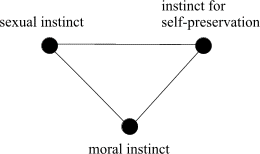CHAPTER XI
Moral Instinct as a Partial Introgenic Drive
It is the moral instinct in the human being which takes this evaluation
into consideration intuitively.
Is there such an instinct? According to the chapter on the inimical powers of assimilation and paranoia, it could appear as though no place for moral sensibility existed: as though the assimilation drive, the drive to expand, the drive to embody, to destroy, left no room for compassion.
But consider the following illustration. A child climbs onto the railing of a bridge, takes a few steps, and falls into the water. Fright and horror grips those who see it.
If man is a thoroughly egotistical being, how does he get the feeling of horror? Several of those present even make the attempt to rescue the child, some of them at the risk of their own lives.
I stated: there is only one drive—the drive for assimilation. Thus even the moral instinct is a partial component of this drive.
I would like to illustrate this fractional part in the form of a triangle: sexual instinct—instinct for self-preservation—moral instinct

One could determine graphically the place of any character among these three poles.
The morally defective character adjoins the line which connects the pole of the sexual to that of the self-preservative instinct; we find the autistic character on the line connecting the self-preservative instinct and the moral instinct; the altruistic character is situated near the line of the sexual instinct—moral instinct. A graphic character line cuts diagonally across the triangle. Even the sexual instinct and the instinct for self-preservation, rather than being independent instincts, are partial components of the primal drive; one acts in the interest of ontogenesis—self-preservative instinct, the second in the interest of the collective—moral instinct, the third in the interest of phylogenesis—sexual instinct.


